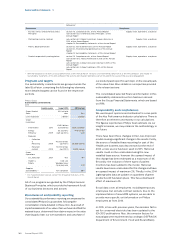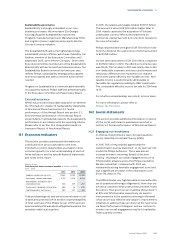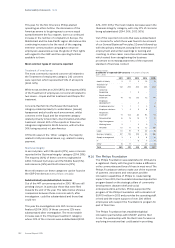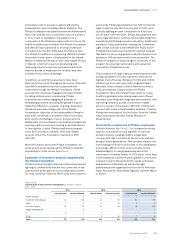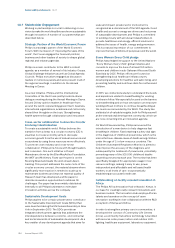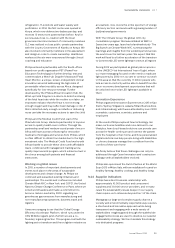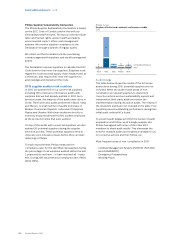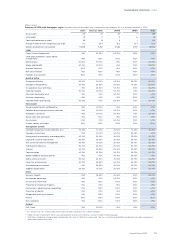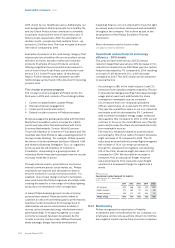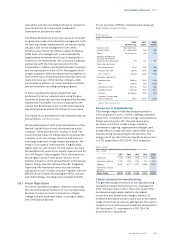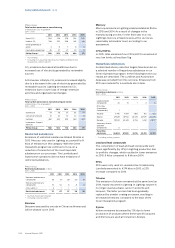Philips 2015 Annual Report Download - page 195
Download and view the complete annual report
Please find page 195 of the 2015 Philips annual report below. You can navigate through the pages in the report by either clicking on the pages listed below, or by using the keyword search tool below to find specific information within the annual report.Sustainability statements 14.2.7
Annual Report 2015 195
refrigeration, IT-solutions and water supply and
purication. In 2014, the rst center was opened in
Kenya, which now delivers two babies per day, and
receives 13 times more patients than before. Key for
success was close co-creation with the local
government and involvement of community members.
CLC was realized in close public-private partnership
with the County Government of Kiambu in Kenya. We
also involved community members in the assessment
and design in order to create ownership. Healthcare
workers at the site were empowered through clinical
coaching and education.
Philips entered a partnership with the South-Africa
based non-prot organization PET (PowerFree
Education Technology) to further develop, test and
commercialize a Wind-Up Doppler Ultrasound Fetal
Heart Monitor, a unique, power-independent clinical
innovation aimed at addressing the high rates of
preventable infant mortality across Africa, designed
specically for low-resource settings. Further
developed by the Philips Africa Innovation Hub, the
Wind-up Fetal Doppler is a device to detect a slowing
of the fetal heart rate while the mother is in labor, an
important indicator that the fetus is not receiving
enough oxygen and may suer brain damage or die. If
this is detected early enough, a midwife or delivering
nurse can take the necessary actions to save the child.
Philips and the Medical Credit Fund, part of the
PharmAccess Group, started a partnership to improve
access to quality health care in Africa. Through the
partnership small and medium-sized private clinics in
Africa will have access to nancing for innovative
medical technologies and services from Philips, which
is often dicult to obtain from banks due to the high
investment risks. The Medical Credit Fund works with
African banks to provide these clinics with aordable
loans, combined with management training and a
quality improvement program, which enhances trust in
the clinics among both patients and nancial
institutions.
Working on global issues
In 2015, a number of important developments and
events took place in the areas of sustainable
development and climate change. At Philips we
continued and expanded existing initiatives and
partnerships. The events and conferences included
Climate Week NYC in New York, and COP21, the United
Nations Climate Change Conference in Paris, where we
joined world leaders and made a commitment to
become carbon-neutral by 2020, regarding our
greenhouse gas emissions from manufacturing and
non-manufacturing operations, business travel and
logistics.
It was encouraging to see that the Global Energy
Eciency Accelerator Platform, which runs under the
UN’s SE4All program (and of which we are a co-
founder), is gaining traction. This program, built with the
lighting sector transition and the en.lighten initiative as
an example, now covers the entire spectrum of energy
eciency sectors, and works with a growing number of
(sub)national governments.
With The Climate Group, the global ‘LED city
consultation program’ that was initiated at WEF in
Davos two years ago, launched a landmark study ‘The
Big Switch’ at Climate Week NYC, summarizing the
learnings and insights from the workshops held across
the world over the last two years. We expect that this
work will lead to a further acceleration of the transition
to (connected) LED street lighting in cities in all regions.
During 2015 we participated as global patron sponsor
in the UNESCO-led International Year of Light, where
our main messaging focused on the need to eradicate
light poverty by 2030. It is our aim to continue our work
in this area so that the currently 1.1 billion people who
lack access to electricity will be able to benet from the
socio-economic development opportunities that will
be unlocked once solar LED lighting is available to
them.
Innovation Experience
Philips organized Innovation Experiences in 2015 in Sao
Paolo, Sydney, Singapore, Jakarta, Milan, Buenos Aires,
and Johannesburg, which were attended by over 2,200
journalists, customers, scientists, partners and
employees.
At the events Philips explored how technology can
make our homes healthier and more tailored to our
lifestyles, how cloud-based solutions can provide care
across the health continuum and connect the patient
from the hospital to their home, and how personalized
digital solutions can help people living with disabilities
or chronic diseases manage their condition from the
comfort of their own home.
We rmly believe that these challenges can only be
addressed through Open Innovation and constructive
dialogue with all stakeholders involved.
Philips also sponsored the Dutch Pavilion at the World
Expo 2015 in Milan, Italy, with an installation focused on
healthy farming, healthy cooking, and healthy living.
14.2.8 Supplier indicators
Philips has a direct business relationship with
approximately 10,000 product and component
suppliers and 30,000 service providers, and in many
cases the sustainability issues deeper in our supply
chain require us to intervene beyond tier 1 of the chain.
Managing our large and complex supply chain in a
socially and environmentally responsible way requires
a structured and innovative approach while being
transparent and engaging with a wide variety of
stakeholders. Insights gained through the stakeholder
engagement process are used to develop our supplier
sustainability strategy. We then translate this strategy
into dedicated programs.



